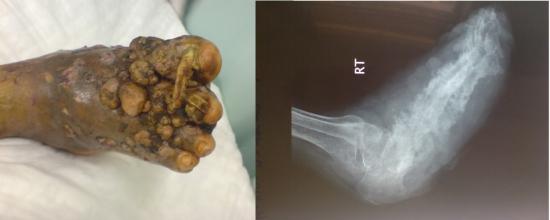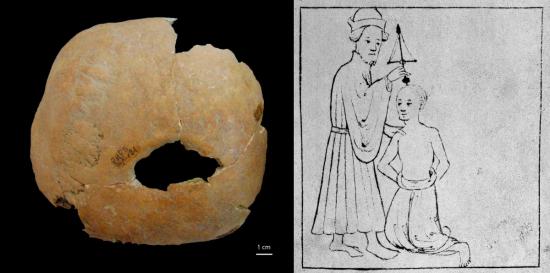Kristina Killgrove
Source - http://www.forbes.com/sites/kristinakillgrove/2016/02/23/archaeologists-find-medieval-foot-fungus-in-portuguese-cemetery/#296574e4674d
 Ankylosis of the left calcaneus and cuboid (3D imaging available here). (A) Photography showing external foci (black arrow). (B) Radiograph showing multiple foci (black arrows) and the lines (white arrow) between the calcaneus and cuboid. (Image used with kind permission of Ana Curto.)
Ankylosis of the left calcaneus and cuboid (3D imaging available here). (A) Photography showing external foci (black arrow). (B) Radiograph showing multiple foci (black arrows) and the lines (white arrow) between the calcaneus and cuboid. (Image used with kind permission of Ana Curto.)
In an unassuming cemetery in Estremoz, southern Portugal, archaeologists found over 100 burials dating to the 13th to 15th centuries AD. One middle-aged man, however, had a hole in his head and clear evidence of disease in his left foot. Their diagnosis? A foot fungus that has never been seen in Medieval Europe before.
The skeleton in question was studied by biological anthropologists Ana Curto and Teresa Fernandes, who report their findings in the latest issue of the International Journal of Paleopathology. The man’s left heel and ankle bones were fused together, and the heel bone also has a worm-eaten appearance, with round holes found throughout. All five of the metatarsals in his left midfoot show evidence of destruction and irregular healing. His left lower leg also seems to have been compromised by the same disease. Curiously, the right foot is totally normal.
Based on these ancient “symptoms,” Curto and Fernandes attempted a differential diagnosis, excluding some diseases and finally settling on one. They first ruled out diseases present since birth, narrowing their focus to diseases that can be acquired during life. The pattern of bone lesions doesn’t match well with leprosy or cancer, both of which also involve destruction of bone. Tuberculosis and osteomyelitis (infection of the bone marrow) also don’t match well, but the anthropologists could not definitively exclude those causes.
 Left: Patient with Madura foot in King Saud Medical Complex, Riyadh, Saudi Arabia. (Image by Wikimedia Commons user Halfalah, used under a CC-BY-SA 3.0 license.) Right: Madura foot x-ray of patient at King Saud Medical Complex, Riyadh, Saudi Arabia. (Image by Wikimedia Commons user Halfalah, used under a CC-BY-SA 3.0 license.)
Left: Patient with Madura foot in King Saud Medical Complex, Riyadh, Saudi Arabia. (Image by Wikimedia Commons user Halfalah, used under a CC-BY-SA 3.0 license.) Right: Madura foot x-ray of patient at King Saud Medical Complex, Riyadh, Saudi Arabia. (Image by Wikimedia Commons user Halfalah, used under a CC-BY-SA 3.0 license.)
Rather, the one-sided foot symptoms match best with maduromycosis, more commonly known as Madura foot after the place in India where it was first medically reported in the mid-19th century. Madura foot is caused by a fungus that lives in soil, so is very common among barefoot agricultural workers. In modern cases, a person cuts their foot, and the fungus gets in and produces colonies. After a long but painless incubation period, the fungus spreads through the skin and into the bone, causing widespread destruction. In ancient times, Madura foot was hard to get rid of, and amputation was likely the only cure.
What’s odd about Madura foot in this Medieval Portuguese cemetery, though, is that the disease is usually confined to between 30°N and 15°S latitudes, or further south than Estremoz. Can Madura foot make it up to Portugal, and if so, how?
Curto and Fernandes think that the Medieval Climatic Anomaly of 1000-1400 AD may be to blame. During that time, Europe was warmer and drier than during the Little Ice Age, meaning the pathogen that causes Madura foot could theoretically have survived in the soil of southern Portugal. However, the researchers can’t rule out the possibility that this man got infected somewhere else — such as the Mediterranean, or even the Middle East or Africa — and came to Portugal afterwards.
 Left: Oval shaped trauma (approximately 31 × 21 mm) at the right parietal of a middle-aged man from Estremoz, Medieval Portugal. Probable trepanation. (Image used with kind permission of Ana Curto.) Right: Medieval (13th century) surgeon trepanning. (Image by Wellcome Images, a website operated by the Wellcome Trust, a global charitable foundation based in the UK. Used under a CC-BY license.)
Left: Oval shaped trauma (approximately 31 × 21 mm) at the right parietal of a middle-aged man from Estremoz, Medieval Portugal. Probable trepanation. (Image used with kind permission of Ana Curto.) Right: Medieval (13th century) surgeon trepanning. (Image by Wellcome Images, a website operated by the Wellcome Trust, a global charitable foundation based in the UK. Used under a CC-BY license.)
The other odd thing about this man’s skeleton is the hole in his head. It’s oval in shape, and right in the middle of the side of the cranial vault. Remodeling on the margins of the hole means he survived the wound and had started healing. Since there are no radiating lines, it isn’t a fracture, and it’s unlikely to be a cancer either. Curto and Fernandes are confident it is evidence of trepanation, or skull surgery. Someone would have scraped his cranial bone in a back-and-forth manner until the bone wore out, causing a hole.
Trepanation was practiced in ancient times — and is still practiced in places today — as a way to cure disease, release evil spirits, or bring the person to a higher level of consciousness. While trepanation suggests that medical therapy was applied to this man, the researchers cannot be sure if it relates in any way to his Madura foot.
Only two other cases of Madura foot have been reported in the literature on ancient skeletons: one from Mexico dating to between 1300-100 BC, and one from Israel dating to between 300-600 AD. This new case from southern Portugal is therefore important not only as an addition to the literature but as an indication that climate change may have influenced the spread of this disease.
As Curto summed up for me, ”This finding reminds us how the study of palaeopathology can give us a better understanding of diseases today. It also shows the impact that cultural changes — like the use of footwear — can have on disease distribution.”
To read more about this case, read Ana Curto and Teresa Fernandes’s article, “A possible Madura foot from medieval Estremoz, southern Portugal,” in the June 2016 issue of the International Journal of Paleopathology. Or, if you want to play with a 3D model of the diseased heel bone, check out their model here at SketchFab.